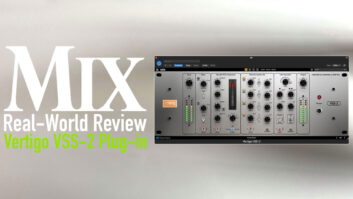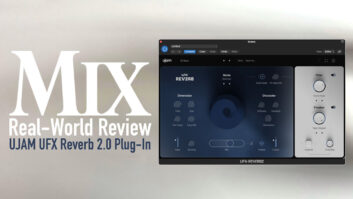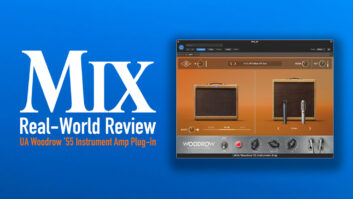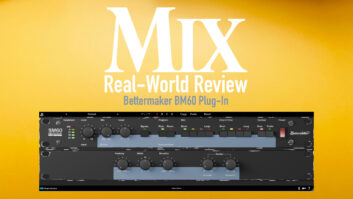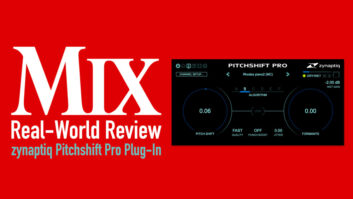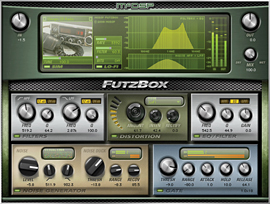
FutzBox offers a variety of controls for managing the noise generator, speaker modeler and other lo-fi effects.
Noise and distortion have become the sound producer/
engineer’s friends! Used in the proper context, distortion and noise can place a vocal or instrument track in a soundscape familiar to the listener. For film/TV work, post-production mixers often chain distortion/noise processors to tailor dialog to fit the scene’s action, mood and location. And the right noise/distortion vocal treatment can reinforce the meaning, mood and presentation of a song’s lyrics.
McDSP’s FutzBox is an all-in-one distortion, noise generator, low-fidelity processor and speaker-sound modeler that accomplishes the work of several processors usually required for distortion/noise treatments. Available as TDM or RTAS format for Macs and PCs, FutzBox offers up to seven sections to create just the right amount of desired noise and distortion to otherwise perfectly good recordings.
Seven Futz Sections
The seven Futz sections are fixed in order and follow the order of typical outboard chains used in post-production. The order is: Filter, Distortion, EQ/Filter, Simulated Impulse Responses, Gate and Lo-Fi. The Noise Generator signal is added before the SIM section, with the latter setting FutzBox’s “mood” by processing the sound as if it were coming though your choice of more than 160 devices, such as home stereo speakers, car radios, guitar amps, telephones, pipes or tin cans.
The library of SIMs is organized into 13 banks: cell phones, containers (trash cans, buckets, etc.), ear buds, headphones, radios, small electronics (boom boxes), speakers, telephones, televisions, toys, vehicles, wireless (walkie-talkies and CB radios) and other (guitar amps, hoses and answering machines.) Each SIM is unique and a Tune control adjusts parts of its algorithm, resulting in different effects depending on the SIM — sounding sometimes like it’s a phasing control and other times changing the resonance of a filter.
The Lo-Fi section downsamples audio. Three sliders control the sample rate: Down (as low as 1,336 Hz), Filtering (lowpass to roll off the aliasing noise — or not) and Bit Depth (24-bit down to horrible sounding 2-bit audio).
The Filter section has controls for two high- and lowpass resonant filters, both with 20 to 20k Hz ranges. There is a choice of 12 or 24dB/octave curves and variable Q values numbered from 0 (broadest) to 100 (sharpest). The shape of these filters’ action is shown in a large display along with the separate input and output meters.
The EQ/Filter section has a Mode switch that changes it to a single-frequency parametric, or high- or lowpass filter. You can boost/cut up to 12 dB with adjustable Q.
The Distortion section adds grunge and filth using ten different “modes” or presets with evocative names like Stun, Nuke and Clip. The Amount knob controls the level of distortion; Intensity changes tone; and Rectify “chops” off the negative-going part of the waveform in a controllable way. Rectify has the effect of reducing most of the low-frequency content, while adding more fizziness — sounding like a cheap fuzz pedal.
The Noise Generator section makes broadband continuous white noise and works together with the Gate section. NG adds background hiss to bolster realism for walkie-talkie or radio and space communication effects. You can “sculpt” the noise’s spectral bandwidth with 20 to 20k Hz high- and lowpass filters. The shape of this filter is shown in a separate graphic below the Filter/EQ/Filter graphic.
The NG’s Duck function causes the hiss to be reduced to any level (Range) whenever audio passes through FutzBox. The user can control the threshold level (Duck Threshold) and how long it takes the noise to come back (Recovery) when audio throughput ceases.
The Gate section is a hyper-sensitive noise gate with Threshold, Range, Attack, Hold and Release controls. It’s especially designed to imitate the choppy nature of static and signal dropouts common in cell phone or radio communication audio. The Gate works on FutzBox’s entire audio output and reduces the overall noise floor (or not) for extremely noisy treatments.
Let’s Get Futzing
I installed FutzBox into my Pro Tools HD3 Accel rig with no problems; it also works in HD, 003, MBox and Venue D-Show systems. It runs in session up to 96 kHz, although it requires an Accel card to do it. It’s iLok-authorized, and there are both stereo and mono versions. All the controls — including the Wet/Dry control — are automatable, so transitioning into a Futz’d treatment can be as smooth as you want. Auditioning is fast; the different SIMs come up instantly with no waiting time to load impulses.
While mixing a rock record, the producer I was working with asked if I could make the lead vocal sound like it was coming over a bad two-way radio. I used Antique Tube Radio 1 SIM, set the HP/LP filter to 150 Hz and 8 kHz, and the Distortion mode was Sat 2 with good levels of Amount, Intensity and Rectification. The EQ/Filter added “squawkiness” at 1.13 kHz, and the Noise Generator and Gate sections were set so there was constant noise “riding” along with, but just under, the vocal and cutting off when the singer stopped. Adjusting parameters is instant, although the faders for the SIM Tune and the LoFi section are small and a little hard to adjust.
I next trashed a fine drum sound using the Distortion section (Amount at 10.6; Intensity at 37.8), 70Hz highpass filter and a 3.3dB boost at 1 kHz with broad Q. The drum sound went from clean and punchy to sounding to like an overloaded boom box recording.
I liked using the Large Studio Monitor SIM (Tune at 155) to process a direct bass guitar track. I added Distortion (Sat 1 with Amount 5.9, Intensity 100 and no Rectify) and a 1.9dB boost at 120 Hz. My direct bass recording got an amp and cabinet — clean and real sounding.
FutzBox provided a credible guitar sound from a direct guitar recording using SIM Guitar Amp 2 (Tune at 122); a 6kHz roll-off in the Filter; Distortion on Nuke with an 89.9 Amount/83 Intensity/11.1 Rectify; and the EQ/Filter set to boost 3.6 dB at 3.4 kHz with Q set to 31. I added McDSP’s CompressorBank 1 compressor plug afterward, as FutzBox has no compressor section.
Noisy Go-To Processor
Destined to be very popular with post-production mixers and sound designers, FutzBox is also a worthwhile addition to any music mixer’s plug-in folder. It was perfect for adding analog grease, dirt and vibe to any clean and clear guitar, drum, vocal and bass guitar recording. It’s become my go-to plug when I’m stumped — when a track needs something but I’m not sure what.
Barry Rudolph is an L.A.-based recording engineer/mixer. Visit
www.barryrudolph.com.



